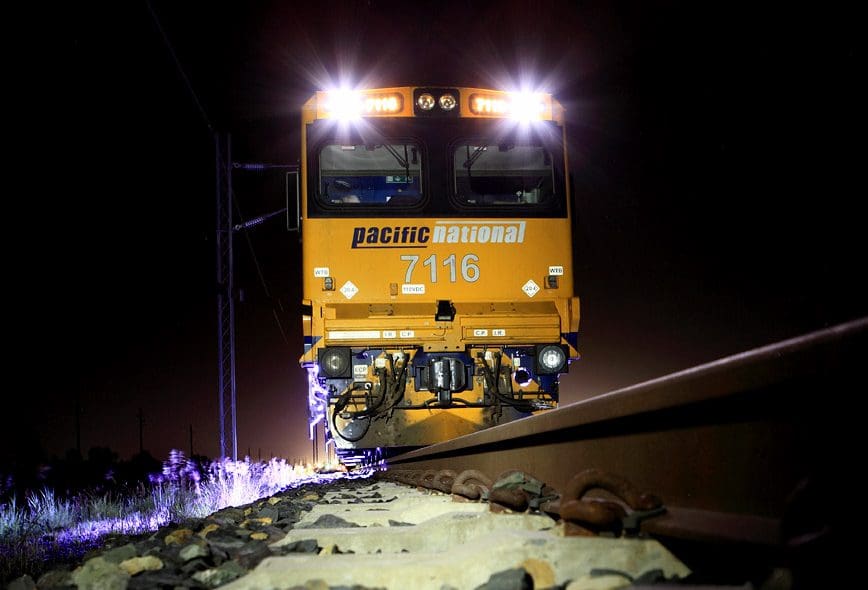
Pacific National and Aurizon have commenced projects to investigate ways to improve lighting on locomotives Photo: Pacific National
AUSTRALIAN rail freight operators, Aurizon and Pacific National (PN), are conducting lighting trials in effort to improve safety at level crossings across the country.
The project is being coordinated through the Freight on Rail Group and the Office of the National Rail Safety Regulator (ONRSR).
Both operators are undertaking the trials in unison at different sites.
An Aurizon spokesperson said the company is conducting two lighting trials with CBH Group in Western Australia.
“The first relates to higher-efficiency lighting and replacing halogen headlights on locomotives with LED headlights that are brighter and longer-lasting,” the spokesperson said.
“The second relates to new front-mounted headboard lights that are being integrated with the existing ditchlight circuits so they are activated when the locomotive is approaching a level crossing.
“A range of factors will be considered as part of the trials, including engineering performance and visibility.
“The trials are expected to be completed by the end of May.”
PN is conducting trials principally in the Hunter Valley and regional New South Wales, with the trials expected to be completed by the end of June.
It is anticipated that information and learnings will be shared between the two operators as the trials progress.
The project comes after a campaign was launched by the families of two men who died in a level crossing collision near Young, in NSW.
The truck they were travelling in collided with a moving freight train as it crossed south of Eurabba Lane on February 23, 2021.
The families believed improved visibility, such as, more lighting at level crossings and on the locomotives, could have prevented the tragedy from occurring.
New train lighting concept
Further illustrating the need for upgrades to train and level-crossing lighting, rail-safety expert Brett Hughes last month released a concept aimed at providing best-practice recommendations for how operators can improve locomotive visibility.
Dr Hughes created this concept with support from representatives from 12 families who have had members killed as a result of collisions with freight or passenger trains at passive level crossings.
Named Yarramony Lights after the 2000 fatal incident in WA that claimed three lives, the concept calls for flashing, outline and side lighting to be installed on locomotives.
This is in addition to side lighting and upgraded reflectors on wagons.
Dr Hughes said the concept is in response to a ONRSR and Australasian Centre for Rail Innovation (ACRI) Freight Train Visibility review report released earlier this year.
“The ACRI report makes it clear, conspicuity on the front of trains needs to be improved with flashing lights (rotating beacons), more than one colour, outline lighting and a unique signature,” Dr Hughes said.
“Conspicuity on the side of trains also needs to be improved as well as other facets of level-crossing safety, including low-cost warning systems at level crossings.
“Instead of excuses and problems, railways should be looking for solutions like this.
“Their problem now is that it can be demonstrated that they could be operating safer, so they may be held legally accountable in some future crash.
“The Yarramony Lights concept is an example of lighting that meets the requirements of the ACRI report released this year.”

ONRSR chief executive Sue McCarrey
More testing needed by operators
The ACRI report identified and assessed 30 potential rolling stock, design and/or education controls that may improve rail-freight vehicle visibility and driver awareness when interacting with passive level crossings.
ONRSR chief executive and National Rail Safety Regulator, Sue McCarrey, said at this stage there is limited evidence regarding the effectiveness of these controls, emphasising the need for further testing and evaluation by freight operators.
“It is important to note that while we are really encouraged by the review identifying a range of possible risk controls, at this point in time they have only been assessed to the extent that they are possible solutions,” Ms McCarrey said.
“What we have to do now is have the industry take the initiative and commit to trialling these controls where appropriate to collect the evidence as to their effectiveness as longer-term safety measures.”
According to Dr Hughes, there are about 14 level-crossing crashes and over 200 near-misses each year in Australia.
The grain industry is a major user of the rail freight network, with approximately 55 per cent of Australia’s exported product hauled by trains.
Grain Central: Get our free news straight to your inbox – Click here



There is a basic underlying problem which the authorities refuse to address. That is a rail safety system that refuses to take an open minded and broad approach to rail trauma incidents. In investigating rail trauma the investigators work to maximise the blame on third parties and minimise the blame on rail and rail operators. At the most basic level, and as shown in the photo at the start of this article, the front of trains are NOT designed to minimise trauma. The couplers spear into vehicles and trap them while they are destroyed. It would be a simple and cost effective process to fit moveable barriers to the front of trains to maximise the chance of vehicles and people being pushed away from the front of the train.
A beginning at last! Something also has to be done about the lights on the crossing itself. The obvious solution that springs to my mind is a solar powered battery driving the flashing lights.